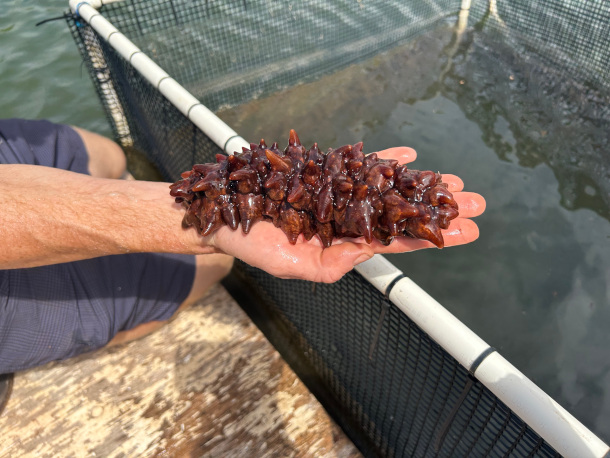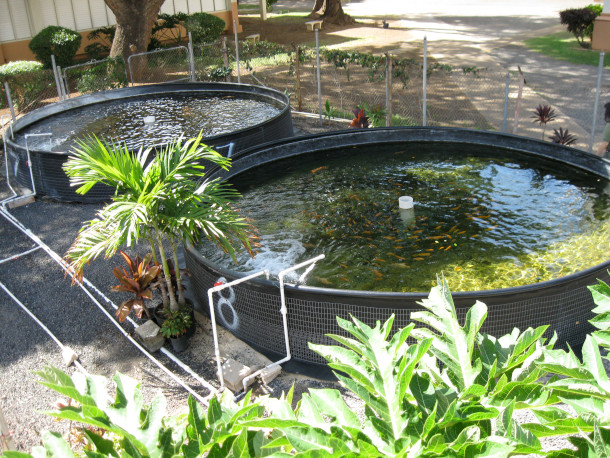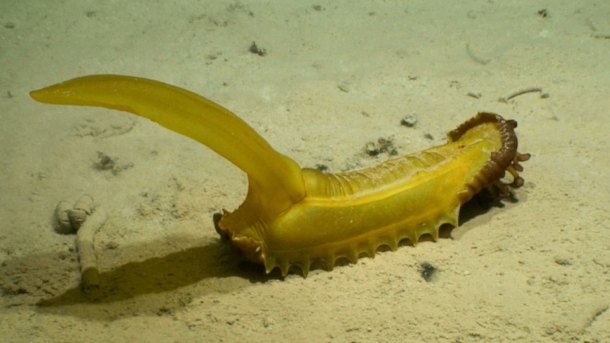Sea Cucumbers Clean Up Fish Poop
Air Date: Week of July 14, 2023

Kauai Sea Farm has started adding these spiky sea cucumbers to their aquaculture system to help them clean up waste. (Photo: Courtesy of Kiley Price)
Fish waste can spread diseases and lead to harmful algae blooms in aquaculture, so some fish farmers are enlisting the help of sea cucumbers that eat organic debris and leave behind clean sediment. Freelance journalist Kiley Price shares with Host Jenni Doering how it works and why farmers face some challenges in adding sea cucumbers to their aquaculture operations.
Transcript
DOERING: Too many nutrients can degrade both fresh and saltwater ecosystems, and that’s a big problem for aquaculture, or fish farming. The industry supplies over half of the seafood that humans around the world eat every year, according to the National Oceanic and Atmospheric Administration. And as aquaculture continues to grow, farmers are finding themselves dealing with all the waste their fish produce. That muck can spread diseases and lead to harmful algal blooms. Now some fish farmers are enlisting the help of an often-overlooked sea creature. Sea cucumbers live on the ocean floor at all depths and vacuum up algae and the organic debris called “marine snow”, leaving behind clean sediment. Using sea cucumbers to clean up fish waste in commercial operations is still in its early stages, but it’s rooted in a longstanding traditional practice of raising multiple aquatic species as a way of mimicking natural ecosystems. Freelance journalist Kiley Price has reported on this for Yale e360 and she’s here to tell us more. Welcome to Living on Earth, Kiley!
PRICE: Thank you. It's good to be here.
DOERING: So, for this story, you visited a business called Kauai Sea Farm. Can you tell me a bit about what kinds of seafood they raise and how their system works?
PRICE: Kauai Sea Farm is a traditional Hawaiian fishpond. It's called a loko i'a. It's been in Lynn Taylor, who is the owner of Kauai Sea Farm, it's been in her family for more than a hundred years. And the way that Hawaiian fishponds work is that they have this series of gates that connects the pond to the ocean. And the fish come in from the ocean when they're babies, and then they get really big and they eat a lot in the pond, and then they're too big to get out. And that is a traditional Hawaiian technique, and the way that they've built the pond really goes back very far. It really depends on what comes in, on what day, what they're farming. So when I was there, I saw some barracuda. They told me there are some tilapia in there. Mullet is a big one. And then they also have a land-based hatchery.

Aquaculture, or the farming of aquatic plants and animals, provides a major portion of the world’s seafood — and the industry continues to grow. (Photo: Bytemarks, Flickr, CC BY 2.0)
DOERING: So, you visited this fish farm on Kaua'i to learn about how they're using sea cucumbers as part of their system. Those are kind of these big, slimy, aquatic, slug-like things, right?
PRICE: Yeah, that pretty much sums it up exactly, actually. There's over 1200 species of sea cucumbers, so you're going to have a really broad spectrum of how they look, what color they are, the size. There's a few that they're focusing on raising, but the ones I saw while I was there were these big, red, spiky sea cucumbers. I was able to hold one, we did a scuba dive to go get it, and I held it once we got back up to the surface. And I would say it was like, half the size of a baguette. And it was really slimy and kind of like moving around a little bit. Yeah, it was, it was a really interesting experience. I don't even know what I would compare it to.
DOERING: So, why are these things -- these cool, slimy, maybe they have all kinds of different colors and textures -- why are they potentially useful at fish farms?

Raising lots of captive fish leads to a lot of waste, which can accumulate and cause disease or algal blooms. (Photo: Bytemarks, Flickr, CC BY 2.0)
PRICE: Yeah, this is honestly what drew me to the story, I would say. I was really surprised that such a humble-looking creature could have this much of an impact. So, basically, sea cucumbers are bottom-dwellers in the wild. So, they're responsible for kind of gobbling up all of the waste that fish produce, and that's actually their favorite snack. So, it's a good thing for them, the waste that the fish are producing. Everything poops. Poop is going to be an ever-present problem in mass-scale either fishing or agricultural systems. The fish are producing this waste that normally is really difficult to get out of the water, and might actually lead to diseases because of the bacteria in the waste. It can also accumulate at the bottom of the tank. And in that scenario, there's nutrients in it that could eventually lead to algal blooms, if you're in an offshore-based system. It could also kind of suck the oxygen from the system, which can be really dangerous for fish, because fish need oxygen too. So yeah, all in all, it's so crucial to get the waste out of the system so that it's not just floating around in there. What's unique about the sea cucumbers is that it's like one man's waste is another man's treasure, literally in this scenario.
DOERING: So, I understand that using sea cucumbers to clean up farmed fish waste is just one example of something called integrated multi-trophic aquaculture, or IMTA. What is this, and what's the motivation behind it?

Some aquaculture operations are turning to sea cucumbers to consume that waste. These bottom-dwellers come in all shapes and sizes; above is Psychropotes longicauda, also known as the “gummy squirrel.” (Photo: NOAA Ocean Exploration, Flickr, CC BY-SA 2.0)
PRICE: So, integrated multi-trophic aquaculture is this technique that really is trying to mimic nature. So, basically, the goal is to have different marine species along the food chain. You might have fish, and then you might have sea cucumbers, which are a step below on the food chain. It's this very circular system, at least theoretically. You can add multiple things to an IMTA system, so you don't have to just have two things. In an ideal world, for some farmers, you could even have fish, and then kelp, and bivalves, and then sea cucumbers. And then, fortunately, you can sell all of them as products. And sea cucumbers can go for really high prices on the international market. In Asian markets, they are considered a delicacy. They can be frozen, they can be -- mostly they're dried. They can even be eaten as sashimi. There are countries across Asia that have been raising multiple marine species together in one system for a long time. So, you might find, like, shrimp in the same system as sea cucumbers, or other things like that.
DOERING: So, it sounds like even though the idea of integrated multi-trophic aquaculture, or IMTA, is not new, it is still not very common in commercial aquaculture in the U.S. So, what are some of the challenges to scaling up these strategies?

Raising sea cucumbers alongside fish is one example of what’s known as “integrated multi-trophic aquaculture.” The technique, which aims to mimic natural ecosystems, can incorporate several species along the food chain — including bivalves like mussels. (Photo: Peter D. Tillman, Flickr, CC BY-SA 2.0)
PRICE: I would say one of the big ones is policy-related. Aquaculture in different countries kind of has different policies. So, in the United States, really across all of North America, and then in Europe as well, it is a bit newer of an industry than compared to countries in Asia, particularly China. And there aren't really policies that have caught up to it. So, you might file one permit to raise mullet, and then you'll have to file another permit to raise sea cucumbers and another to raise kelp, and they might even be in different departments. Another barrier to this is, it is hard growing more than one marine species at once. There are predominantly monocultures in the United States, in Canada, in Europe. These people are pros at raising that one species, so you might have a salmon farmer that knows everything about salmon farming. But then when you introduce a sea cucumber into their system, how can you expect them to have that equal amount of knowledge? Another barrier is that these farms, to scale up to the level that they want to, are probably going to need their own sea cucumber hatchery and are going to need to artificially spawn them, so, get them to reproduce. And that's really tough because sea cucumbers are little weirdos.
DOERING: Why is that so hard? I mean, they don't just naturally reproduce, make babies?
PRICE: They do, but scientists aren't sure how every species does it yet. So, you know, there's theories that it could be related to different lunar cycles, different water temperatures, things like that. So, they are surprisingly finicky when it comes to spawning. So, the folks at Kauai Sea Farm are working with researchers at the University of Hawai'i right now to figure out how to artificially spawn a couple different species of sea cucumbers, and then see which ones perform best in the pond. And that is a barrier that some of the other farmers outside of Hawai'i had mentioned to me, like in Canada. In order for this to work and to be economically viable, they do need to invest in their own hatchery. So, I think right now, where it's at with integrated multi-trophic aquaculture is, there is a lot of buzz around it, but there are these barriers. And from what I gathered, a lot of farmers are looking to other farmers almost as guinea pigs, to see how this might work. Like a, 'Let's sit back. Let's see how this is going to go. And as soon as there is a reason for me to do this, then maybe I can do it.'
DOERING: Kiley Price is a freelance journalist who wrote about this for Yale e360. Thank you so much, Kiley.
PRICE: Thank you so much for having me.
Links
Check out Kiley’s story about farmers enlisting sea cucumbers
Living on Earth wants to hear from you!
Living on Earth
62 Calef Highway, Suite 212
Lee, NH 03861
Telephone: 617-287-4121
E-mail: comments@loe.org
Newsletter [Click here]
Donate to Living on Earth!
Living on Earth is an independent media program and relies entirely on contributions from listeners and institutions supporting public service. Please donate now to preserve an independent environmental voice.
NewsletterLiving on Earth offers a weekly delivery of the show's rundown to your mailbox. Sign up for our newsletter today!
 Sailors For The Sea: Be the change you want to sea.
Sailors For The Sea: Be the change you want to sea.
 The Grantham Foundation for the Protection of the Environment: Committed to protecting and improving the health of the global environment.
The Grantham Foundation for the Protection of the Environment: Committed to protecting and improving the health of the global environment.
 Contribute to Living on Earth and receive, as our gift to you, an archival print of one of Mark Seth Lender's extraordinary wildlife photographs. Follow the link to see Mark's current collection of photographs.
Contribute to Living on Earth and receive, as our gift to you, an archival print of one of Mark Seth Lender's extraordinary wildlife photographs. Follow the link to see Mark's current collection of photographs.
 Buy a signed copy of Mark Seth Lender's book Smeagull the Seagull & support Living on Earth
Buy a signed copy of Mark Seth Lender's book Smeagull the Seagull & support Living on Earth

